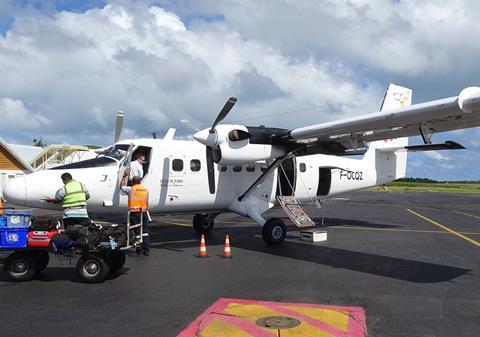French investigators have disclosed that a De Havilland DHC-6 Twin Otter crew resorted to aerodynamic manoeuvring and ground effect to land the aircraft after its engines failed to respond to power commands during approach.
The aircraft – operated by New Caledonian carrier Aircalin – had been carrying out a visual approach to runway 25 at Futuna island’s Pointe Vele airport, following a cargo flight on 4 May 2021.
French investigation authority BEA states that the crew expected turbulence from a northwest wind during the manually-flown approach, and increased the approach speed by 10kt accordingly.
The Twin Otter’s speed increased to 90kt as it descended through 400ft, and the captain, who was flying, retarded the throttle levers to ‘idle’.
But when he advanced the throttle levers again, after reducing speed, the aircraft continued to slow.
The captain made several inputs to the throttle levers until they reaches the ‘full power’ position, but BEA says these successive actions “seemed to have no effect”.
Speed bled away to 62kt and the captain pushed the aircraft into a nose-down attitude to maintain margin above the 56kt stall speed. This enabled the aircraft to accelerate to 66kt, and the captain then flared and used ground effect to reach the runway and touch down. Neither pilot, the only occupants, was injured and the Twin Otter (F-OCQZ) was undamaged.

BEA says the aircraft was not equipped with flight recorders, and the inquiry relied on crew testimony.
While the crew only tested the right-hand Pratt & Whitney PT6A engine on the ground, finding it unresponsive to the throttle lever, the captain believes the issue was not asymmetric, arguing that compensating for asymmetry without being aware of it would have been impossible.
The captain also told investigators that the aircraft was “normally noisy” but there was neither noise nor nose-up sensation when he tried to increase power.
BEA says the crew did not monitor the engine parameters – probably because they were concentrating on the visual approach – but “did not observe” any asymmetry.
It discovered that, within the three months prior to the incident, four malfunctions relating to engine-power problems on the ground had been recorded in the aircraft’s technical log. None of these problems was reproduced during subsequent maintenance operations.
But examination of the fuel control units of both engines revealed an “unusual level” of contamination – a mix of environmental elements and grease, probably engine oil – which BEA says could cause operational faults “such as a lack of increase in engine power”. It adds, however, that this was not established with certainty during the inquiry.





























